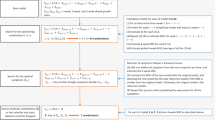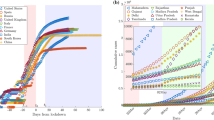Abstract
The evolution of the cumulative number of infections, and the duration of Covid-19 outbreaks, are modeled and predicted, through a novel curve fitting approach overcoming the limitations of existing models, which on one hand focus on short-term forecasts, and on the other hand fail in estimating the duration of epidemic waves. The ingenuity of the CovidCurve model lies in the precise parameter estimation from the cumulative growth of infected individuals in the logarithmic scale. This approach enables the prediction of the size and duration of Covid-19 outbreaks in their beginning with minimal, macroscopic, public information, thus outperforming existing models in predictive power, speed, reliability, and simplicity. CovidCurve generates forecasts through forward extrapolation, and therefore it is able to predict the cumulative growth of confirmed Covid-19 cases throughout an epidemic wave, thus surpassing compartmental (SI, SIR, SEIR) epidemic models, timeseries analysis, and Machine Learning methods, which produce only short-term and mostly inaccurate predictions. The CovidCurve model is precise even during the exponential increase of Covid-19 cases, well before the peak of the infection rate, where existing exponential models fail, due to the inaccurate estimation of their exponent, and their failure to predict the duration of Covid-19 outbreaks. The validity and forecasting precision of the CovidCurve model are demonstrated for twelve countries, namely Greece, India, Argentina, Italy, Spain, Portugal, Denmark, Sweden, Norway, Israel, Romania, and Saudi Arabia


























Similar content being viewed by others
Research data policy and data availability statements
The datasets generated during and/or analysed during the current study are available from the corresponding author on reasonable request.
References
Abbasimehr H, Paki R, Bahrini A (2022) A novel approach based on combining deep learning models with statistical methods for covid-19 time series forecasting. Neural Comput Appl 1–15
Al-Qaness MA, Ewees AA, Fan H et al (2020) Optimization method for forecasting confirmed cases of covid-19 in china. J Clin Med 9(3):674
Anastassopoulou C, Russo L, Tsakris A et al (2020) Data-based analysis, modelling and forecasting of the covid-19 outbreak. PloS One 15(3):e0230405
Balak N, Inan D, Ganau M et al (2021) A simple mathematical tool to forecast covid-19 cumulative case numbers. Clin Epidemiology Glob Health 12(100):853
Busari S, Samson T (2022) Modelling and forecasting new cases of covid-19 in nigeria: Comparison of regression, arima and machine learning models. Sci Afr 18(e01):404
Ceylan Z (2020) Estimation of covid-19 prevalence in italy, spain, and france. Sci Total Environ 138817
Chakraborty T, Ghosh I (2020) Real-time forecasts and risk assessment of novel coronavirus (covid-19) cases: A data-driven analysis. Chaos Solit Fractals 109850
Da Silva RG, Ribeiro MHDM, Mariani VC et al (2020) Forecasting brazilian and american covid-19 cases based on artificial intelligence coupled with climatic exogenous variables. Chaos Solit Fractals 139(110):027
Fanelli D, Piazza F (2020) Analysis and forecast of covid-19 spreading in china, italy and france. Chaos Solit Fractals 134(109):761
Hamzah FB, Lau C, Nazri H et al (2020) Coronatracker: worldwide covid-19 outbreak data analysis and prediction. Bull World Health Organ 1:32
Hu Z, Ge Q, Li S et al (2020) Artificial intelligence forecasting of covid-19 in china. Int J Educ Excell 6(1):71–94
Kucharski AJ, Russell TW, Diamond C et al (2020) Early dynamics of transmission and control of covid-19: a mathematical modelling study. The lancet infectious diseases
Kumari P, Singh HP, Singh S (2021) Seiaqrdt model for the spread of novel coronavirus (covid-19): A case study in india. Appl Intell 51:2818–2837
Kuniya T (2020) Prediction of the epidemic peak of coronavirus disease in japan, 2020. J Clin Med 9(3):789
Lewis TG, Al Mannai WI (2021) Predicting the size and duration of the covid-19 pandemic. Front Appl Math Stat 6(611):854
Mohimont L, Chemchem A, Alin F et al (2021) Convolutional neural networks and temporal cnns for covid-19 forecasting in france. Appl Intell 1–26
Peng L, Yang W, Zhang D et al (2020) Epidemic analysis of covid-19 in china by dynamical modeling. arXiv:2002.06563
Petropoulos F, Makridakis S (2020) Forecasting the novel coronavirus covid-19. PloS One 15(3):e0231236
Remuzzi A, Remuzzi G (2020) Covid-19 and italy: what next? Lancet
Ribeiro MHDM, da Silva RG, Mariani VC et al (2020) Short-term forecasting covid-19 cumulative confirmed cases: Perspectives for brazil. Chaos Solit Fractals 109853
Roda WC, Varughese MB, Han D et al (2020) Why is it difficult to accurately predict the covid-19 epidemic? Infect Dis Model
Roosa K, Lee Y, Luo R et al (2020) Real-time forecasts of the covid-19 epidemic in china from february 5th to february 24th, 2020. Infect Dis Model 5:256–263
Singh KK, Kumar S, Dixit P et al (2021) Kalman filter based short term prediction model for covid-19 spread. Appl Intell 51(5):2714–2726
Sun H, Qiu Y, Yan H et al (2020) Tracking and predicting covid-19 epidemic in china mainland. medRxiv
Vaughan L, Zhang M, Gu H et al (2023) An exploration of challenges associated with machine learning for time series forecasting of covid-19 community spread using wastewater-based epidemiological data. Sci Total Environ 858(159):748
Yang Z, Zeng Z, Wang K et al (2020) Modified seir and ai prediction of the epidemics trend of covid-19 in china under public health interventions. J Thorac Dis 12(3):165
Zhou X, Ma X, Hong N et al (2020) Forecasting the worldwide spread of covid-19 based on logistic model and seir model. medRxiv
Acknowledgements
The author wishes to thank the Editor-in-Chief, the Associate Editor, and the four anonymous Reviewers for their constructive and valuable comments, which substantially contributed to the improvement of the manuscript.
Author information
Authors and Affiliations
Corresponding author
Ethics declarations
Competing interest
The author has no competing interests to declare that are relevant to the content of this article. The author has no relevant financial or non-financial interests to disclose. The author certifies that he has no affiliations with or involvement in any organization or entity with any financial interest or non-financial interest in the subject matter or materials discussed in this manuscript. The author has no financial or proprietary interests in any material discussed in this article.
Additional information
Publisher's Note
Springer Nature remains neutral with regard to jurisdictional claims in published maps and institutional affiliations.
Rights and permissions
Springer Nature or its licensor (e.g. a society or other partner) holds exclusive rights to this article under a publishing agreement with the author(s) or other rightsholder(s); author self-archiving of the accepted manuscript version of this article is solely governed by the terms of such publishing agreement and applicable law.
About this article
Cite this article
Lymperopoulos, I.N. CovidCurve: curve fitting modeling and early forecasting of the size and duration of Covid-19 outbreaks. Appl Intell 53, 29043–29075 (2023). https://doi.org/10.1007/s10489-023-05011-7
Accepted:
Published:
Issue Date:
DOI: https://doi.org/10.1007/s10489-023-05011-7




